Topic 4, Misc. Questions
You are developing a Docker/Go using Azure App Service Web App for Containers. You
plan to run the container in an App Service on Linux. You identify a Docker container image
to use.
None of your current resource groups reside in a location that supports Linux. You must
minimize the number of resource groups required.
You need to create the application and perform an initial deployment.
Which three Azure CLI commands should you use to develop the solution? To answer,
move the appropriate commands from the list of commands to the answer area and
arrange them in the correct order
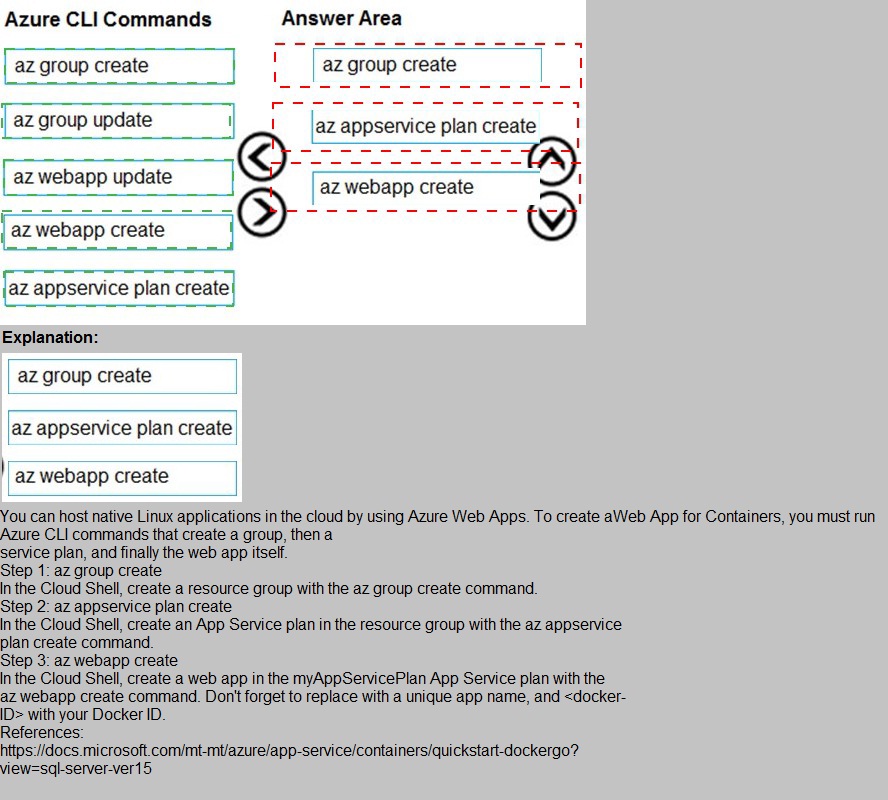
You must ensure that the external party cannot access the data in the SSN column of the
Person table.
Will each protection method meet the requirement? To answer, drag the appropriate
responses to the correct protection methods. Each response may be used once, more than
once, or not at all. You may need to drag the split bar between panes or scroll to view
content.
NOTE: Each correct selection is worth one point.

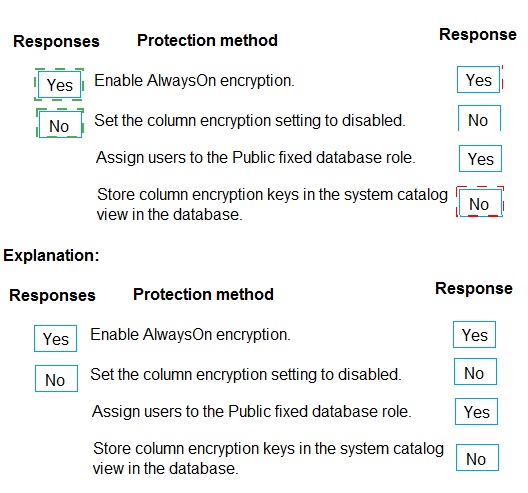
Note: This question is part of a series of questions that present the same scenario.
Each question in the series contains a unique solution that might meet the stated
goals. Some question sets might have more than one correct solution, while others
might not have a correct solution.
After you answer a question in this section, you will NOT be able to return to it. As a
result, these questions will not appear in the review screen.
You are developing an Azure Service application that processes queue data when it
receives a message from a mobile application. Messages may not be sent to the service
consistently.
You have the following requirements:
Queue size must not grow larger than 80 gigabytes (GB).
Use first-in-first-out (FIFO) ordering of messages.
Minimize Azure costs.
You need to implement the messaging solution.
Solution: Use the .Net API to add a message to an Azure Service Bus Queue from the
mobile application. Create an Azure Windows VM that is triggered from Azure Service Bus
Queue.
Does the solution meet the goal?
A.
Yes
B.
No
No
Don't use a VM, instead create an Azure Function App that uses an Azure Service Bus
Queue trigger.
Reference:
https://docs.microsoft.com/en-us/azure/azure-functions/functions-create-storage-queuetriggered-
function
You are preparing to deploy an application to an Azure Kubernetes Service (AKS) cluster.
The application must only be available from within the VNet that includes the cluster.
You need to deploy the application.
How should you complete the deployment YAML? To answer, drag the appropriate YAML
segments to the correct locations. Each YAML segment may be used once, more than
once, or not at all. You may need to drag the split bar between panes or scroll to view
content.
NOTE: Each correct selection is worth one point

You are implementing an order processing system. A point of sale application publishes
orders to topics in an Azure Service Bus queue. The label property for the topic includes
the following data:

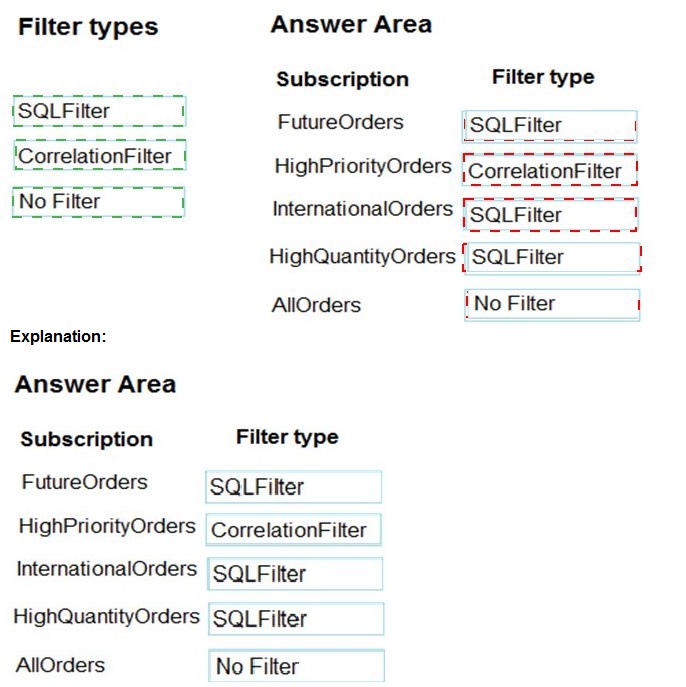
FutureOrders: SQLFilter
HighPriortyOrders: CorrelationFilter
CorrelationID only
InternationalOrders: SQLFilter
Country NOT USA requires an SQL Filter
HighQuantityOrders: SQLFilter
Need to use relational operators so an SQL Filter is needed.
AllOrders: No Filter
SQL Filter: SQL Filters - A SqlFilter holds a SQL-like conditional expression that is
evaluated in the broker against the arriving messages' user-defined properties and system
properties. All system properties must be prefixed with sys. in the conditional expression.
The SQL-language subset for filter conditions tests for the existence of properties
(EXISTS), as well as for null-values (IS NULL), logical NOT/AND/OR, relational operators,
simple numeric arithmetic, and simple text pattern matching with LIKE.
Correlation Filters - A CorrelationFilter holds a set of conditions that are matched against
one or more of an arriving message's user and system properties. A common use is to
match against the CorrelationId property, but the application can also choose to match
against ContentType, Label, MessageId, ReplyTo, ReplyToSessionId, SessionId, To, and
any user-defined properties. A match exists when an arriving message's value for a
property is equal to the value specified in the correlation filter. For string expressions, the
comparison is case-sensitive. When specifying multiple match properties, the filter
combines them as a logical AND condition, meaning for the filter to match, all conditions
must match.
Boolean filters - The TrueFilter and FalseFilter either cause all arriving messages (true) or
none of the arriving messages (false) to be selected for the subscription.
References:
https://docs.microsoft.com/en-us/azure/service-bus-messaging/topic-filters
Your company is developing an Azure API.
You need to implement authentication for the Azure API. You have the following
requirements:
All API calls must be secure.
Callers to the API must not send credentials to the API.
Which authentication mechanism should you use?
A.
Basic
B.
Anonymous
C.
Managed identity
D.
Client certificate
Managed identity
Explanation:
Use the authentication-managed-identity policy to authenticate with a backend service
using the managed identity of the API Management service. This policy essentially uses
the managed identity to obtain an access token from Azure Active Directory for accessing
the specified resource. After successfully obtaining the token, the policy will set the value of
the token in the Authorization header using the Bearer scheme.
Reference:
https://docs.microsoft.com/bs-cyrl-ba/azure/api-management/api-managementauthentication-
policies
A company is developing a mobile app for field service employees using Azure App
Service Mobile Apps as the backend.
The company’s network connectivity varies throughout the day. The solution must support
offline use and synchronize changes in the background when the app is online app.
You need to implement the solution.
How should you complete the code segment? To answer, select the appropriate options in
the answer area.
NOTE: Each correct selection is worth one point.
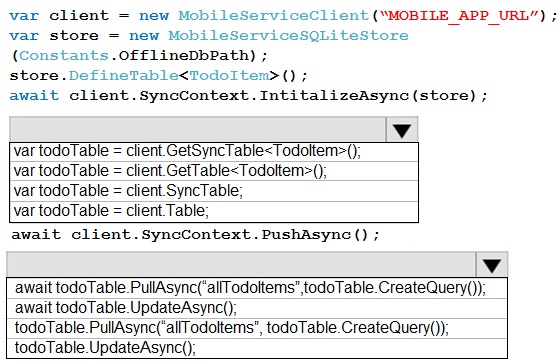

Your company has several websites that use a company logo image. You use Azure
Content Delivery Network (CDN) to store the static image.
You need to determine the correct process of how the CDN and the Point of Presence
(POP) server will distribute the image and list the items in the correct order.
In which order do the actions occur? To answer, move all actions from the list of actions to
the answer area and arrange them in the correct order.
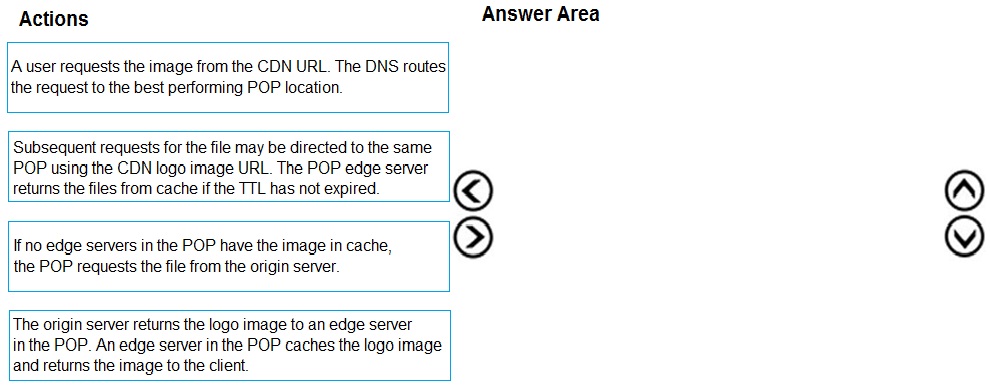
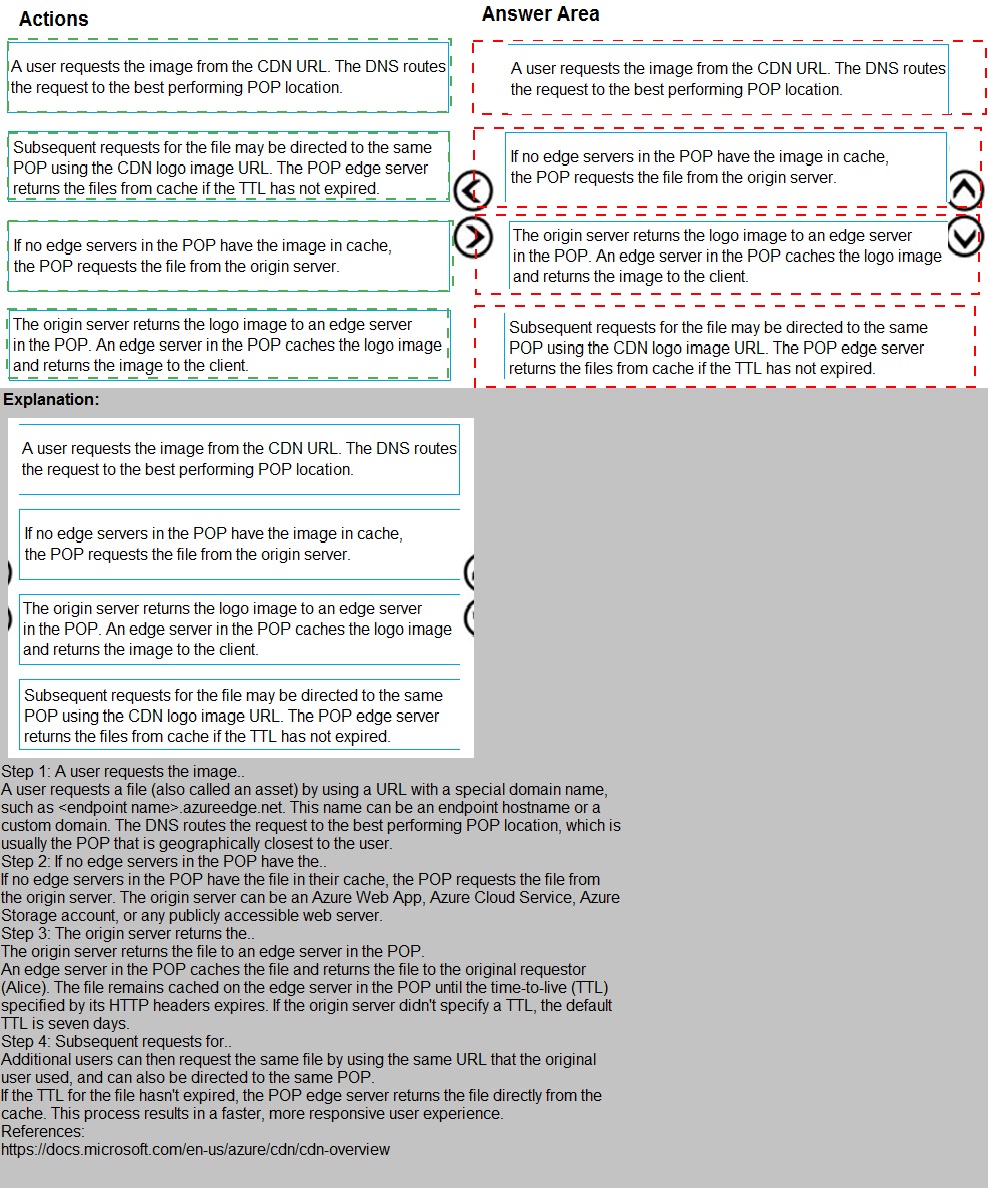
Note: This question is part of a series of questions that present the same scenario.
Each question in the series contains a unique solution that might meet the stated
goals. Some question sets might have more than one correct solution, while others
might not have a correct solution.
After you answer a question in this section, you will NOT be able to return to it. As a
result, these questions will not appear in the review screen.
You develop and deploy an Azure App Service API app to a Windows-hosted deployment
slot named Development. You create additional deployment slots named Testing and
Production. You enable auto swap on the Production deployment slot.
You need to ensure that scripts run and resources are available before a swap operation
occurs.
Solution: Enable auto swap for the Testing slot. Deploy the app to the Testing slot.
Does the solution meet the goal?
A.
Yes
B.
No
No
Instead update the web.config file to include the applicationInitialization configuration
element. Specify custom initialization actions to run the scripts.
Note: Some apps might require custom warm-up actions before the swap. The
applicationInitialization configuration element in web.config lets you specify custom
initialization actions. The swap operation waits for this custom warm-up to finish before
swapping with the target slot. Here's a sample web.config fragment.
<system.webServer>
<applicationInitialization>
<add initializationPage="/" hostName="[app hostname]" />
<add initializationPage="/Home/About" hostName="[app hostname]" />
</applicationInitialization>
</system.webServer>
Reference:
https://docs.microsoft.com/en-us/azure/app-service/deploy-staging-slots#troubleshootswaps
You have an application that provides weather forecasting data to external partners. You
use Azure API Management to publish APIs.
You must change the behavior of the API to meet the following requirements:
• Support alternative input parameters.
• Remove formatting text from responses.
• Provide additional context to back-end services.
Which types of policies should you implement? To answer, drag the policy types to the
correct scenarios. Each policy type may be used once, more than once, or not at all. You
may need to drag the split bar between panes or scroll to view content
NOTE: Each correct selection is worth one point

You are preparing to deploy a medical records application to an Azure virtual machine
(VM). The application will be deployed by using a VHD produced by an on-premises build
server.
You need to ensure that both the application and related data are encrypted during and
after deployment to Azure.
Which three actions should you perform in sequence? To answer, move the appropriate
actions from the list of actions to the answer area and arrange them in the correct order.

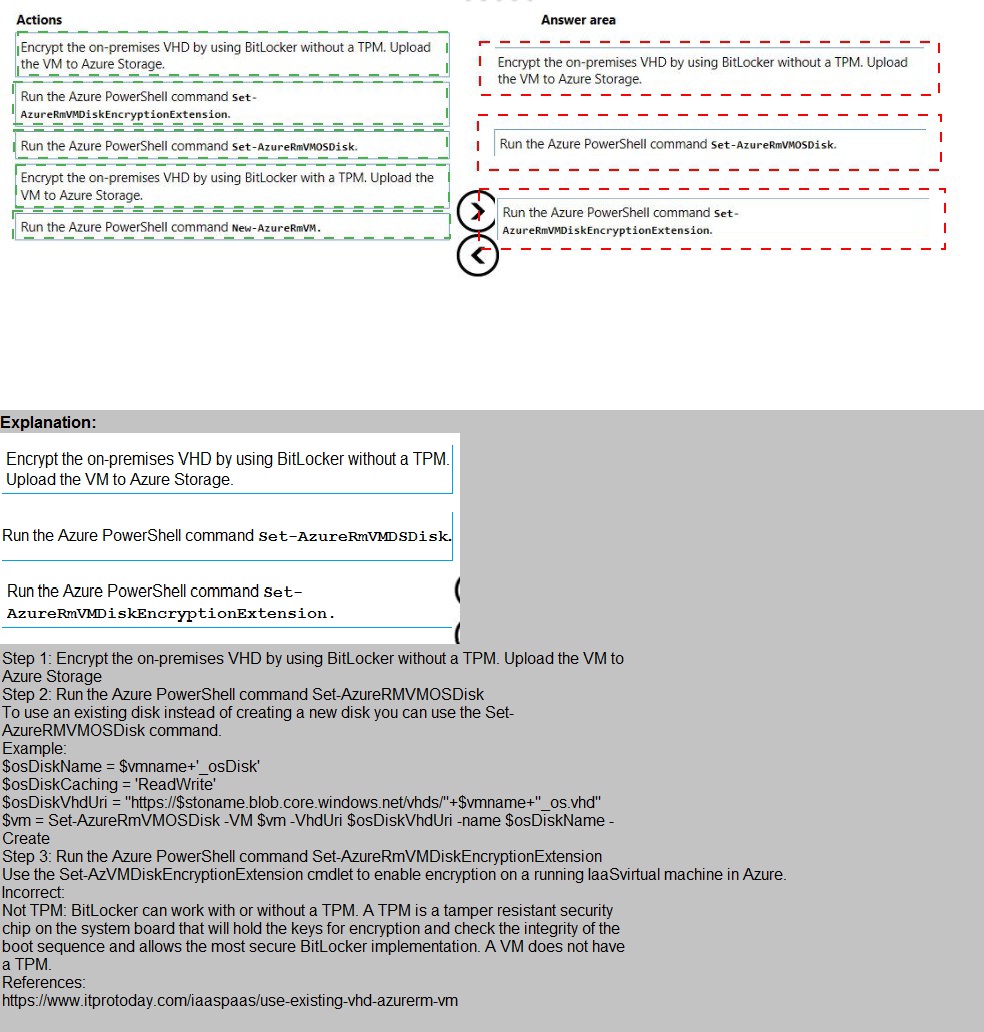
Note: This question is part of a series of questions that present the same scenario.
Each question in the series contains a unique solution that might meet the stated
goals. Some question sets might have more than one correct solution, while others
might not have a correct solution.
After you answer a question in this section, you will NOT be able to return to it. As a
result, these questions will not appear in the review screen.
You are developing an Azure Service application that processes queue data when it
receives a message from a mobile application. Messages may not be sent to the service
consistently.
You have the following requirements:
Queue size must not grow larger than 80 gigabytes (GB).
Use first-in-first-out (FIFO) ordering of messages.
Minimize Azure costs.
You need to implement the messaging solution.
Solution: Use the .Net API to add a message to an Azure Storage Queue from the mobile
application. Create an Azure VM that is triggered from Azure Storage Queue events.
Does the solution meet the goal?
A.
Yes
B.
No
No
Don't use a VM, instead create an Azure Function App that uses an Azure Service Bus
Queue trigger.
Reference:
https://docs.microsoft.com/en-us/azure/azure-functions/functions-create-storage-queuetriggered-
function
| Page 9 out of 23 Pages |
| Previous |